Goals are a priceless commodity in football, so when any club can find a player who can regularly dispatch efforts at goal, it becomes even harder to keep them.
This was exactly the predicament Fulham found themselves in, in the shape of striker Aleksandar Mitrović.
Mitrović was a record-breaker during his time at Craven Cottage, scoring a staggering 43 goals in 44 appearances in the 2021/22 season as Fulham topped the EFL Championship.
His final goal tally that season ensured he scored more individually than the entirety of the Hull City squad in England’s second tier.
The Serb continued to showcase his credentials upon stepping up to the top flight last season, netting 14 goals, placing him in the division’s top 10 goal scorers.
In August 2023, Mitrović departed West London for the Saudi Pro League for a club-record fee of £50 million.
It was an astute business deal by the Cottagers when you consider that the forward was only weeks shy of his 29th birthday at the time of the deal.
His move did, however, leave a cloud over Fulham, with questions arising as to whether Marco Silva’s side could survive a second successive season in the Premier League without their star man.
Silva’s side is proving any doubters wrong, though, as Fulham currently sits in 12th place, 14 points above the drop zone.
This tactical analysis and scout report will look to assess Mitrovic’s role at Fulham and how the West London side has evolved from an attacking perspective since his departure.
We will provide an analysis of the personnel and tactics at Craven Cottage to see if any similarities remain from last campaign as well as any differences.
Mitrović’s presence
If we rewind the clock to last season, Mitrović regularly led the forward line at Fulham.
The Serb was utilised as a target man upfront due to his physical presence.
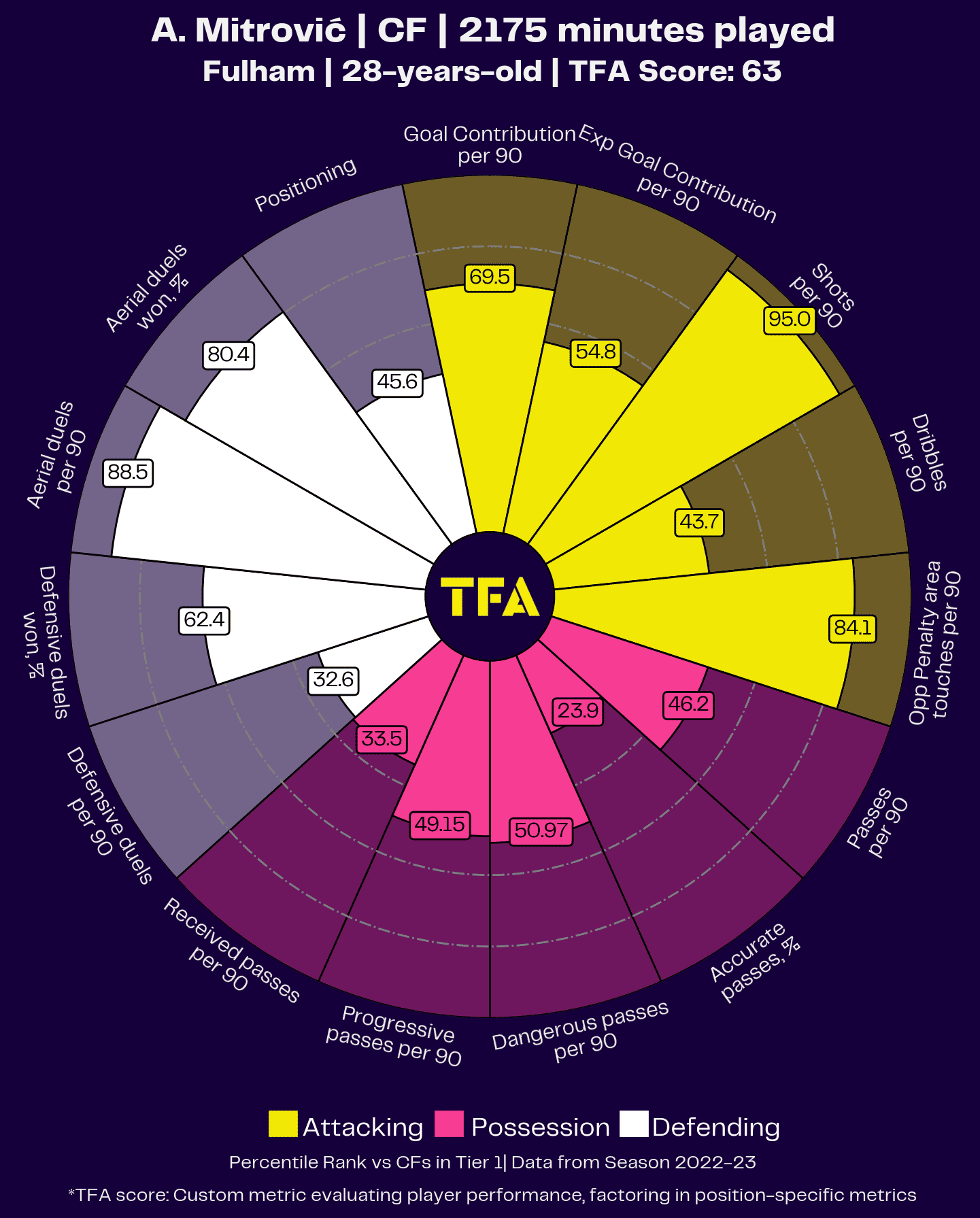
The above pizza plot shows his strong attacking credentials for the Cottagers last season.
Moreover, the graphic highlights Mitrović’s strong aerial ability, as he ranked in the top 20% for percentage of aerial duels won compared to other centre-forwards.
Fulham looked to use Mitrović’s aerial dominance to their advantage by stretching the opposition out wide, often using the absolute width of the pitch, as well as from set pieces.
Silva’s side would look to provide crosses into the area from the flanks, as they averaged 2.55 crosses into the penalty area per 90.
A figure bettered only by Tottenham.
Despite the physicality that Mitrović brought to the front line, Fulham were not one-dimensional in playing long balls up to the Serb.
Silva’s side would look to play out from the back, pushing the full-backs wide with the likes of João Palhinha and Andreas Pereira dropping deeper to provide passing options for the centre-back pairing to progress play forward.
Mitrović would also drop deeper near the halfway line to provide a passing option, such as in the example below.
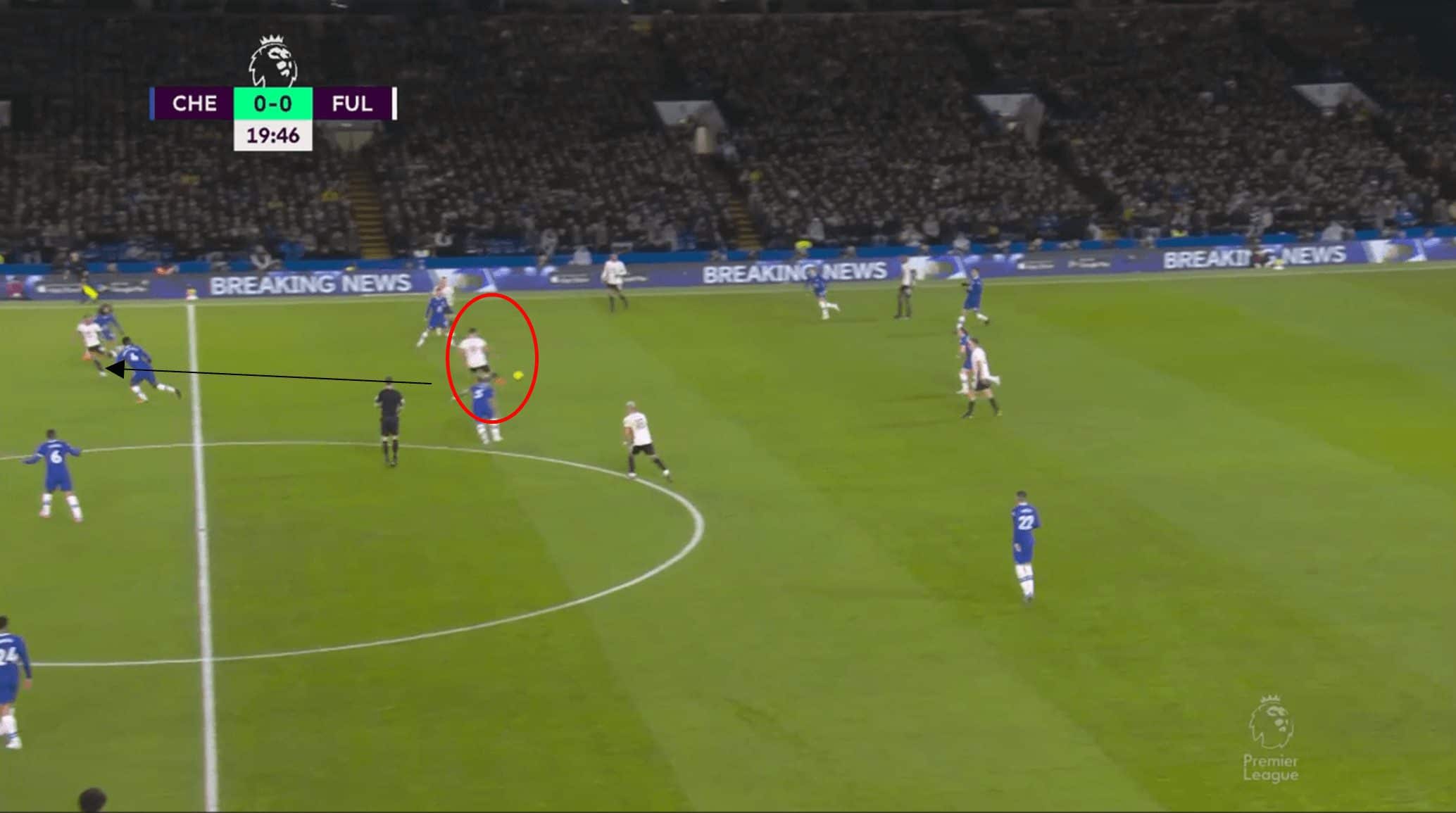
As the Serb dropped deeper, he had the vision to play a first-time pass-through, allowing Fulham to attack Chelsea’s defensive line.
Not all of the former Newcastle forwards’ passing would be so crisp, though.
Sometimes, his passing in deeper areas was much more simplistic but equally enabled Fulham to keep possession ticking over.
Furthermore, his movement in dropping deeper would facilitate switches to the wider areas and also dragged opposition defenders out of position, leaving space to attack.
The forward was certainly a focal point up front, and despite his big stature, he did have a knack for dribbling in the final third and using his strength to keep the opposition at bay.
It should be noted, though, that a weakness of Mitrović’s was his possessional play, as alluded to by the previous pizza plot.
The Serb would often look to play first-time passes, but such balls would sometimes go astray; he would have a tendency to be quite tunnel-visioned when it came to opportunities on goal.
On occasions, Mitrović would shoot on-site, at acute angles at times, despite teammates being placed in better positions.
Nevertheless, the Serb often spearheaded Fulham’s forward options, and the Cottagers were given a taste of life without Mitrović last campaign when he was suspended for eight matches.
During this run of fixtures, Fulham won three and lost five.
Fulham stuck to their usual 4-2-3-1 shape but experimented with the likes of Dan James and Bobby Reid as a false number nine leading the line.
The switch in personnel and tact led to mixed fortunes though and reverting back to a target man, but this time with Carlos Vinícius in attack, proved the better choice.
The Brazilian scored three in his last five league games at the tail end of the season, cementing that Fulham operated better with a target man.
A target man leads the line
With a view to Mitrović departing in the summer transfer window, Fulham brought in reinforcements by bringing in Raúl Jiménez from league rivals Wolves.
The Mexican led Fulham’s attack in the earlier stages of the season.
Jiménez struggled for regular goals but soon hit a rich vein of form in December, scoring four goals in five matches.
His subsequent injury was undoubtedly a blow for the Cottagers, but in his absence, Rodrigo Muniz has stepped up to the role and is one of the division’s form strikers, netting five in his last six appearances.

The table shows various per 90 statistics to compare Mitrović at Fulham last season to the current striking options at Silva’s disposal this season.
The statistics show that not much separates the two current forward options from the Serb as all three forwards are pretty much on par in terms of efficiency in front of goal if you consider their respective goals per-shot conversion rate.
Moreover, Muniz arguably offers more to Fulham’s attacking line on a whole, given his higher assists and key passes per 90, suggesting his importance in unlocking the opposition’s defence.
It is noted that the statistics gathered on Jiménez and Muniz are from a smaller sample size in terms of matches but nevertheless point to players who are filling the Mitrović void.
This is even more the case when you consider how both players have fit into Fulham’s tactics this season, as they are reminiscent of the Serb’s role.
Either Jiménez or Muniz has taken the target man role in a 4-2-3-1 for Fulham this season, dropping deep to provide a link to either the midfield or defence.
In dropping deeper, both forwards have had to showcase strong hold-up play and an aerial presence to help Fulham transition into the final third.
Moreover, Jiménez and Muniz have both had similar pressing duties to Mitrović in the sense they are tasked with instigating a press in a forward two, typically alongside Pereira.
Both forwards have played an important part in Fulham’s off-the-ball 4-4-2 formation as the West Londoners look to keep compact with their shape, making it difficult for opponents to play through the lines.
Although Jiménez has proven useful at switching the play, as Mitrović before him, Muniz does not look to switch when in possession.
The Brazilian is more comfortable turning on the ball with his back to goal to advance play forward than his predecessor.
This increased mobility is noticeable in Muniz and Jiménez, and consequently, Fulham have a slight increase in pace in their forward line this season.
Despite the subtle difference in personnel, Fulham’s ability to provide crosses into the area is still a major feature of their attacking play as they look to use the aerial presence of their striker options.
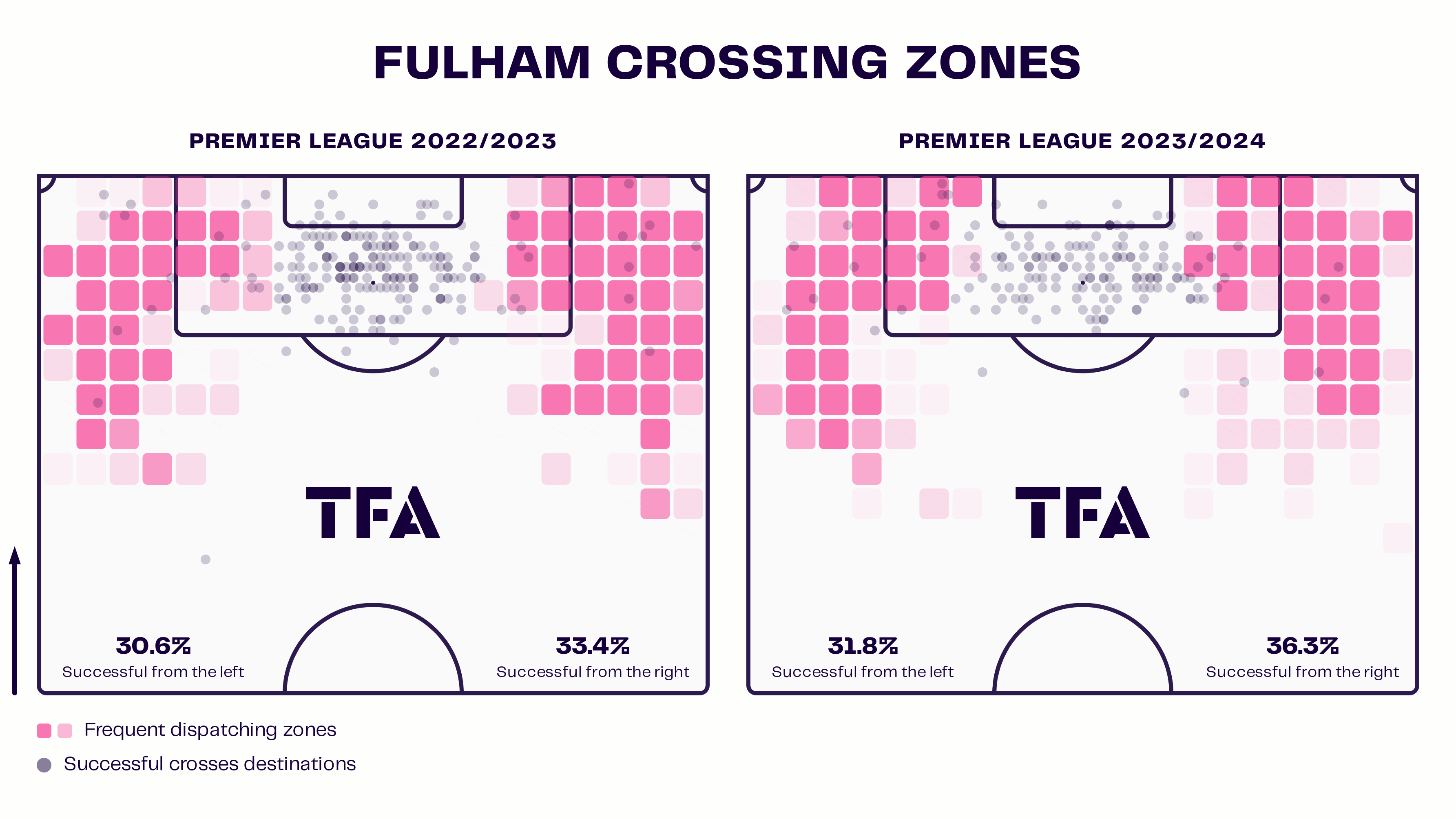
Fulham average 2.39 crosses into the penalty area per 90 this campaign, the joint second-highest figure in the division.
While this is a slight reduction in last season’s average, it still demonstrates the importance of using the flanks in their attacks.
As seen in the above graphic, although Fulham aren’t using the absolute width of the pitch to the same extent as last season, they are still showcasing crossing as an essential attacking outlet.
Moreover, their crossing accuracy has actually increased.
It is, therefore, no coincidence that most of Muniz’s goals this season have come from crosses in the penalty area.
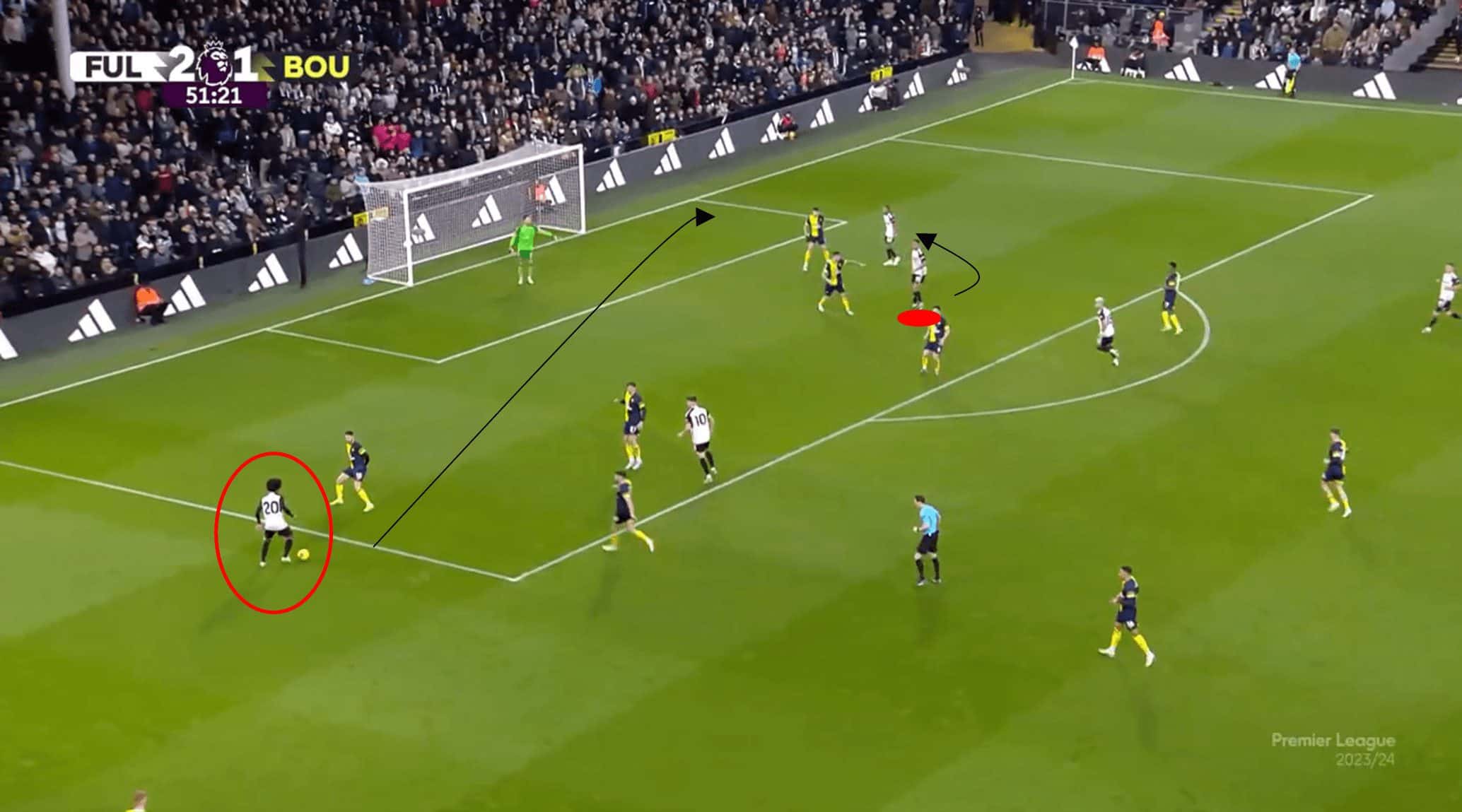
As Fulham have piled forward in numbers, Muniz runs into the area in anticipation of a cross.
Not only is the initial movement instinctive, but his positioning when he gets inside the area is intelligent.
He looks at the opposing defender and notices he is ball-watching.
He subsequently peels off his marker, deciding not to charge into the six-yard box, but instead holds his run.
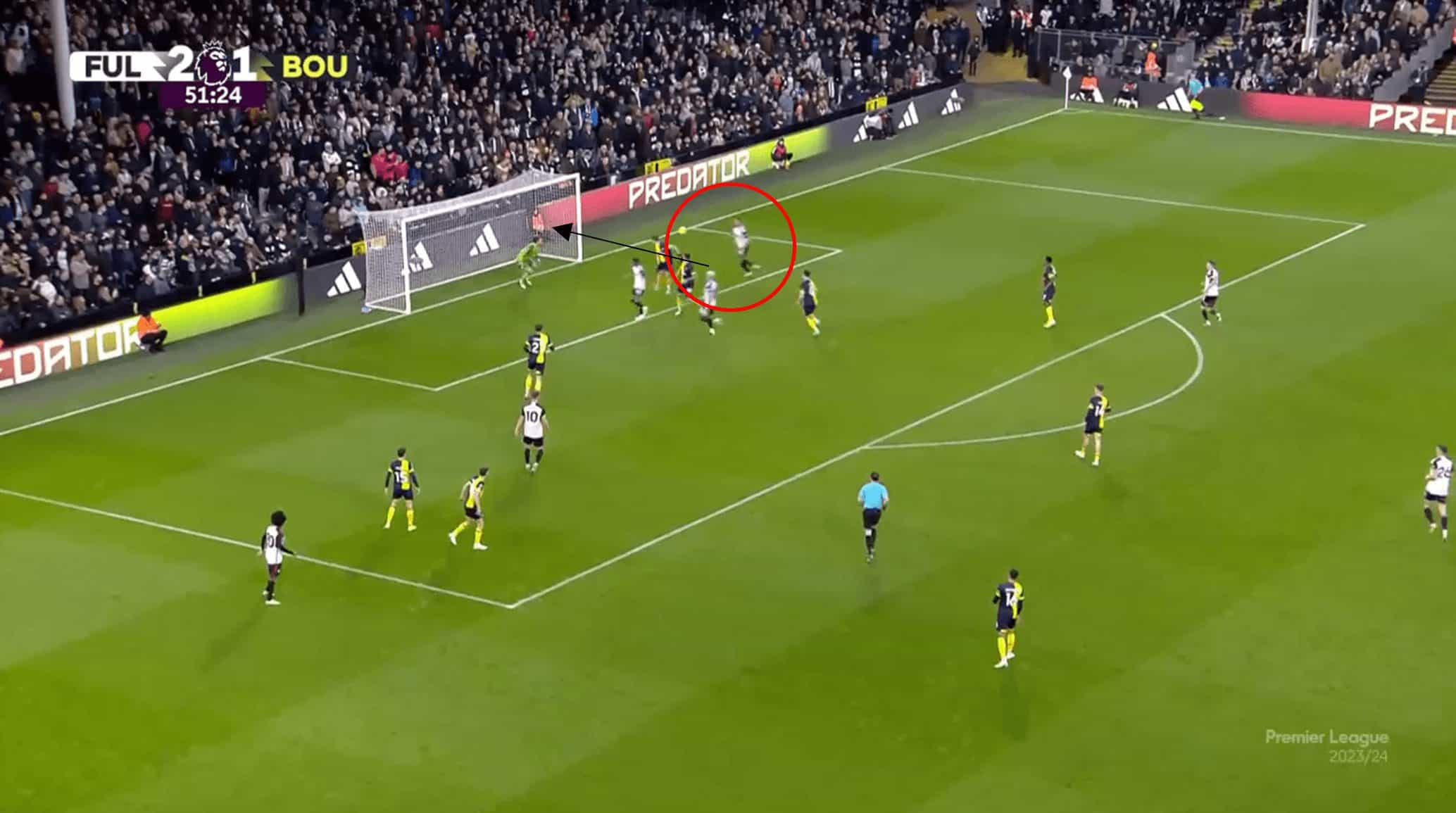
As a result, the opposing defender has a false sense of security, thinking he is about to clear the danger unopposed.
However, the Bournemouth player misses the flight of the ball and it eventually drops to Muniz, unmarked at the back post, who doubles Fulham’s lead.
In recent weeks, Silva has praised Muniz for his potency inside the area and his influence on Fulham’s build-up play.
Although having a striker in form is important, Fulham’s attacking outlet is more than just a product of one individual leading from the front.
A more all-rounded team
The playing style has not changed dramatically since Mitrović’s departure.
Surprisingly, despite his physical presence, Fulham have increased their launched goal kicks by 5% this season.
However, this approach does not define their overall attacking approach.
Fulham’s build-up begins from the back, and they rank in the top half of the league for build-up attacks this season.
It’s easy to forget that this is only Silva’s second season in the top flight with the Cottagers, and the fact Fulham can play so possession-based – particularly at home where they often enjoy more than 60% possession – is no mean feat.
The overarching quality in Fulham’s attacking transitions is the ability of the players to switch and rotate positions.
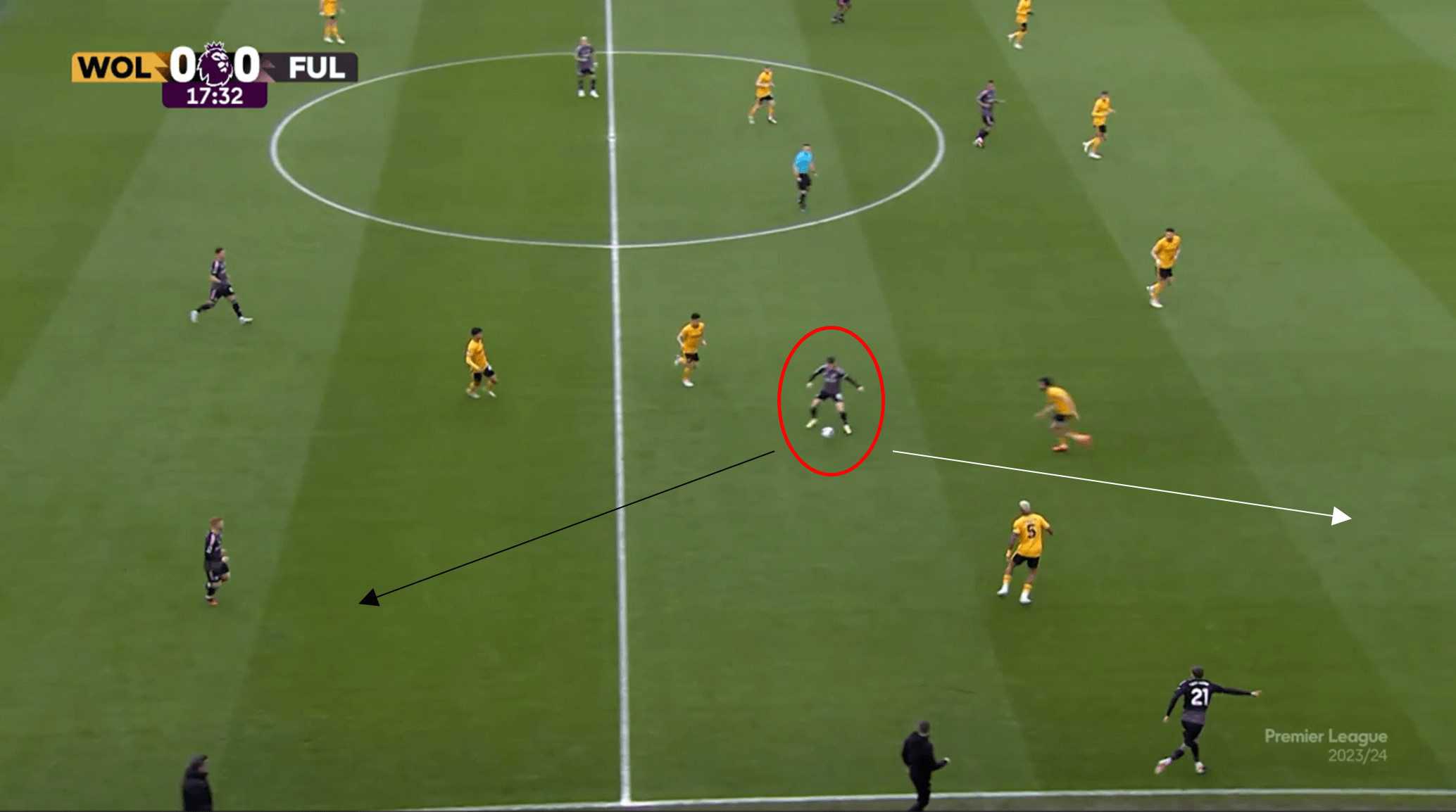
An example is shown above: Harrison Reed has dropped into the right-back role from his usual defensive midfield position.
This has facilitated the right-back, Timothy Castagne, advancing; Harry Wilson, who started on the right of the three supporting midfielders behind the sole striker, has drifted towards the inside channel.
Although Wilson opts to return the pass to Reed in this case, quicker close control would have opened up the opportunity for Castagne to be played in down the wing.
Castagne and his opposite number on the left flank, Antonee Robinson, have been no strangers to supporting Fulham’s attack either from overlapping runs or movements in the half spaces to provide a crossing outlet.
However, on other occasions, the Cottagers have carved out openings from a combination of quick passing triangles and rotations.
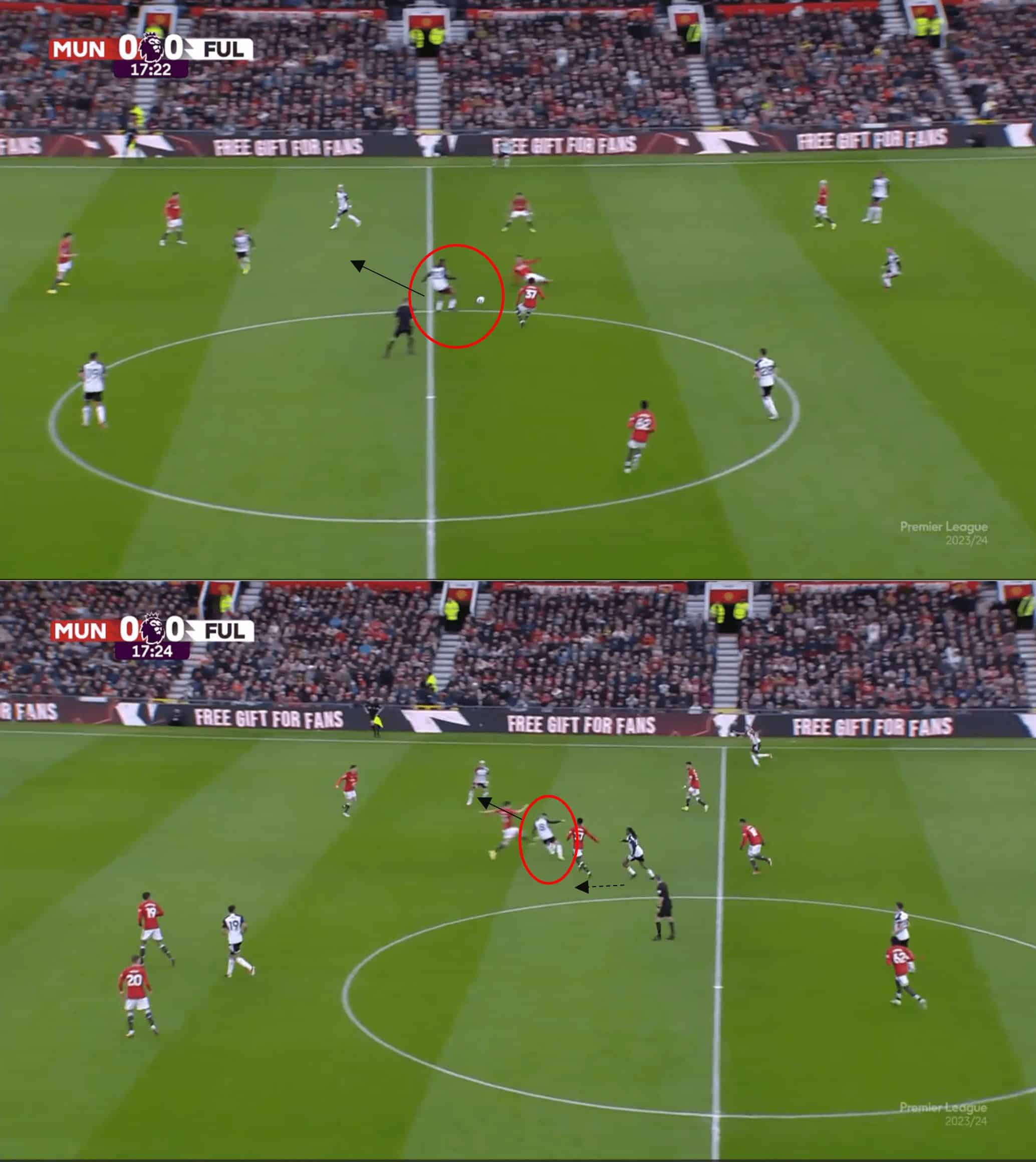
In this case, Alex Iwobi, who was lined up on the left of the attack on paper, dropped deep into a more central position.
Iwobi plays a first-time ball into Wilson, who follows suit in knocking the ball onto Periera.
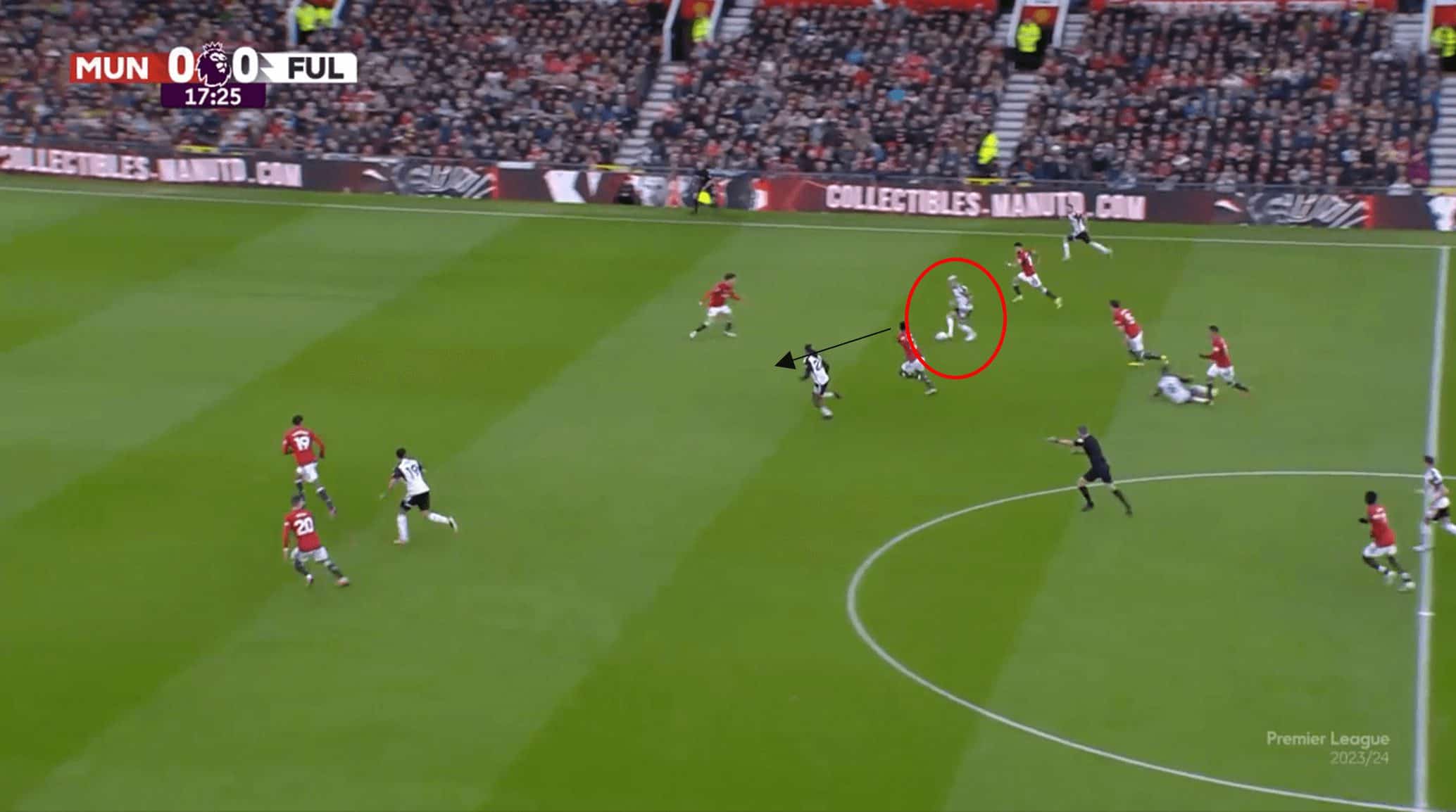
Pereira takes a touch before playing in Iwobi, who has advanced into space left by the Manchester United defence.
Iwobi is eventually able to get a shot away.
The short, quick passing enabled Fulham to attack on the front foot and control the space in the opposition half.
The fluid movements in the final third, combined with a greater injection of pace compared to last season, have led to more openings looking to break the opposition’s defensive line.
Fulham’s pass type this campaign has been exemplified by its increase in average through-ball passes by 1.26 per 90 minutes.
Because of the variety in movements and passing exchanges, Silva’s side has become a greater threat as a team going forward.
For instance, Fulham had 15 different goal scorers in the league last season, and Mitrović accounted for 25% of Fulham’s total league goals.
In contrast, with 10 more games still remaining, Fulham already have 15 different goal-scorers this campaign.
Moreover, in back-to-back five-nil victories earlier this season, Fulham had seven different players on the score sheet.
With the goals more evenly distributed, it goes to show that one player doesn’t make a team.
Conclusion
In this tactical analysis and scout report, we have highlighted the target role that Mitrović played during his time in West London.
We showed how his physical presence and strong aerial ability were a threat that Fulham used to their advantage in getting crosses into the box.
However, this analysis has shown that despite the Serb’s departure, others have stepped up to the same role and are playing to similar high standards.
With the likes of Jiménez and Muniz leading the line, Fulham have enjoyed a steady changing of the guard up front.
There have been subtle differences, though, such as slightly less width covered this season and more pace introduced into the attack, which has led to fluid passing exchanges in the final third.
Fulham seem to have grown as a club this season, showcasing their play as a team rather than being defined by a single player.
They may finally be ready to put their status as a yo-yo club behind them and cement their place in the top flight for years to come.






Comments